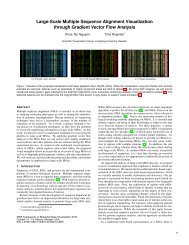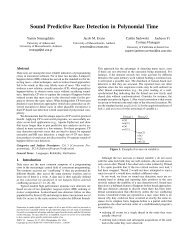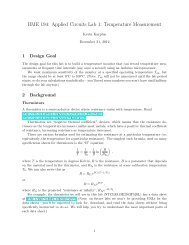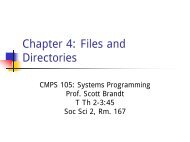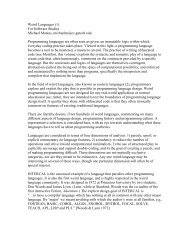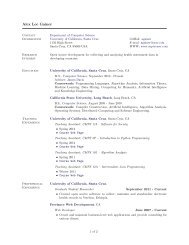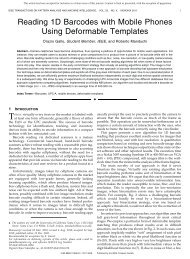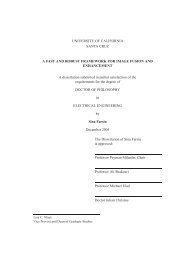Amoeba — A Distributed Operating System for the 1990s - CiteSeerX
Amoeba — A Distributed Operating System for the 1990s - CiteSeerX
Amoeba — A Distributed Operating System for the 1990s - CiteSeerX
Create successful ePaper yourself
Turn your PDF publications into a flip-book with our unique Google optimized e-Paper software.
elegant way to name and protect objects. By using an encryption scheme <strong>for</strong> protecting <strong>the</strong>m,<br />
we moved <strong>the</strong> capability management out of <strong>the</strong> kernel. RPC is an obvious way to implement<br />
<strong>the</strong> request/reply nature of per<strong>for</strong>ming operations on objects.<br />
4 The <strong>Amoeba</strong> File <strong>System</strong><br />
Capabilities <strong>for</strong>m <strong>the</strong> low-level naming mechanism of <strong>Amoeba</strong>, but <strong>the</strong>y are very impractical<br />
<strong>for</strong> use by human beings. There<strong>for</strong>e an extra level of mapping is provided from humansensible<br />
hierarchical path names to capabilities. On <strong>Amoeba</strong>, a typical user has access to literally<br />
thousands of capabilities <strong>—</strong> of <strong>the</strong> user’s own private objects, but also capabilities of<br />
public objects, such as <strong>the</strong> executables of commands, pool processors, data bases, public files,<br />
and so on.<br />
It is perhaps feasible <strong>for</strong> a user to store his own private capabilities somewhere, but it is<br />
quite impossible <strong>for</strong> a system manager, or a project co-ordinator to hand out capabilities explicitly<br />
to every user who may access a shared public object. Public places are needed where<br />
users can find capabilities of shared objects, so that when a new object is made sharable, or<br />
when a sharable object changes, its capability need be put in only one place.<br />
4.1 The Hierarchical Directory Structure<br />
Hierarchical directory structures are ideal <strong>for</strong> implementing partially shared name spaces. Objects<br />
that are shared between <strong>the</strong> members of a project team can be stored in a directory that<br />
only team members have access to. By implementing directories as ordinary objects with a capability<br />
that is needed to use <strong>the</strong>m, members of a group can be given access by giving <strong>the</strong>m<br />
<strong>the</strong> capability of <strong>the</strong> directory, while o<strong>the</strong>rs can be withheld access by not giving <strong>the</strong>m <strong>the</strong> capability.<br />
A capability of a directory is thus a capability <strong>for</strong> many o<strong>the</strong>r capabilities.<br />
To a first approximation, a directory is a set of (name, capability) pairs. The basic operations<br />
on directory objects are:<br />
lookup(DirCap, ObjectName)<br />
enter(DirCap, ObjectName, ObjectCap)<br />
delete(DirCap, ObjectName)<br />
The first one looks up an object name in a directory and returns its capability. The o<strong>the</strong>r<br />
two enter and delete objects from directories. Since directories <strong>the</strong>mselves are objects, a directory<br />
may contain capabilities <strong>for</strong> o<strong>the</strong>r directories, thus potentially allowing users to build an<br />
arbitrary graph structure.<br />
Complex sharing can be achieved by making directories more sophisticated than we have<br />
just described. In reality, a directory is an n + 1-column table with ASCII names in column<br />
0 and capabilities in columns 1 through n. A capability <strong>for</strong> a directory is really a capability<br />
<strong>for</strong> a specific column of a directory. Thus, <strong>for</strong> example, a user could arrange his directories<br />
with one column <strong>for</strong> himself, a second column <strong>for</strong> members of his group, and a third column<br />
<strong>for</strong> everyone else. This scheme can provide <strong>the</strong> same protection rules as UNIX , but obviously<br />
many o<strong>the</strong>r schemes are also possible.<br />
The Directory Service can be set up so that whenever a new object is entered in a directory,<br />
<strong>the</strong> Directory Service first asks <strong>the</strong> service managing <strong>the</strong> object to make n replicas, potentially<br />
physically distributed <strong>for</strong> reliability. All <strong>the</strong> capabilities are <strong>the</strong>n entered into <strong>the</strong> directory.<br />
4.2 The Bullet Server<br />
BOZZA<br />
The Bullet Server is a highly unusual file server. It supports only three principal operations:<br />
8




